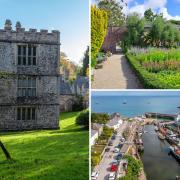With 1700 works held in its attic, Falmouth Art Gallery has asked those most familiar with its collection to choose their most loved. EWEN MACDONALD picks his favourites
Ships, yachts, pleasure craft, boat yards, castles, a harbour, a university, beaches, a river, a sea, shops, cafes, pubs, bars, restaurants, seafood, pizzas, burgers, chips, fine dining, seagulls, milling tourists and lots of exotic plants and trees. Falmouth has all these things, but it also has some great art too.
Falmouth Art Gallery’s latest exhibition is titled Falmouth’s Favourites and is a group of works specifically selected by gallery staff and volunteers.
Sir Terry Frost’s Orchard Tambourine B are woodcuts of four vibrant, tri-coloured panels with a palate of orange, green, blues, purple, pink, and one in monochrome, with a white background, grey outer circle and black inner circle. They’re blurry, popish, inexact compositions, reminding me slightly of the artwork on the cover of Primal Scream’s seminal 90s album Screamadelica. The pictures are fun to view and very untaxing, though I expect the artist was making a deep and meaningful statement with them. I just liked the way they look. Sometimes art should be that simple.
Falmouth school of art alumni Tacita Dean is represented with the piece, A Sequence of Stones - Riesenbett II (floating), Grobsteingrab (floating), Hunengrab II (floating). Three images of rocks float on blackboard paint, ancient and ethereal, as though substances existing from the dawn of time. Like some part of our current obsession with the Rosetta comet and the former planet Pluto. The rocks remain totemic and undiminished and living proof that beauty exists in the most humble and banal objects.
Tilly Kettle’s eighteenth century portrait of A Naval Officer is a painting in which the stated gentleman on display gazes back at us with his mildly enigmatic pose. His eyes are both confident and timid. Not the stare of an arrogant young man in the midst of taking his rightful place in a great new empire. He is humbly and proudly British in his demeanour: all gold braid buttons and half open vest. His hair follicles determinedly trying to stay in place and failing badly, even his crafty combing can’t hold at bay his impending baldness.
Over a century later John Singer Sargent’s Portrait of Charles Napier Hemy is worlds apart, the brushstrokes wonderfully free and expressive and the brushwork clearly visible. The flesh tones cutting, merging, clashing and clinging to the canvas. It appears as though it was painted fast but exquisitely. The face reminding me of Wyatt Earp or the American actor Sam Elliott. There’s a grand sweeping brushstroke on the forehead in this painting that seems wrong, but I like the fact that it looks that way and that people notice the discordant note in its strange swirl.
Sitting juxtaposed with Sargent’s painting is one of Hemy’s own works. Falmouth Natives, is a typically Cornish scene of fishermen dredging for oysters. The sea, a scrim of greens and whites, unfathomable, ferocious and sublime.
In the background HMS Ganges floats, ancient and proud like the men themselves. The sea is everything in Cornwall, a great depiction of it is a must for any painter working in the county. Like the folds of garments for the Greek sculptors and Renaissance painters the contours of the sea takes the utmost dexterity and keenness of eye to capture. Hemy does a sterling job here and seems to knows his business well.
John Opie’s oil painting A Beggar Boy has at its heart an image of a cherubic young boy, all smooth cheeks and curly fringe. This work appears to have been very much posed in the artist’s studio, as the child has no sense of hunger about him, though his pose is one of a sad defiance. It’s difficult to discern what the artist wished to capture. Is he telling us that this poor boy is as worthy of life as us? I certainly concur with that - though I imagine this young lad belongs to a different class altogether. Perhaps it was the artist’s bored son sitting for his father.
Subterfuge there may well be, but it’s still a well-crafted composition. The face is shining out towards us; there is nothing flat about the composition. The brushworks for his beggar’s garb are rough hewn, with faster, more dashing and harder strokes. I enjoyed these marks as I love the painterliness of paint: its plasticity. The movement and texture of it, not simply what it depicts. Opie affords us many delights for the eye in a painting that moves, shimmers and despite its subject matter, is filled with life and joy.
This article first appeared in Cornwall Life September 2015
Love art? Discover Penlee's Museum and Art Gallery collection:http://www.cornwalllife.co.uk/living-cornwall/cornwall-treasures-newlyn-school-at-penlee-gallery/


























